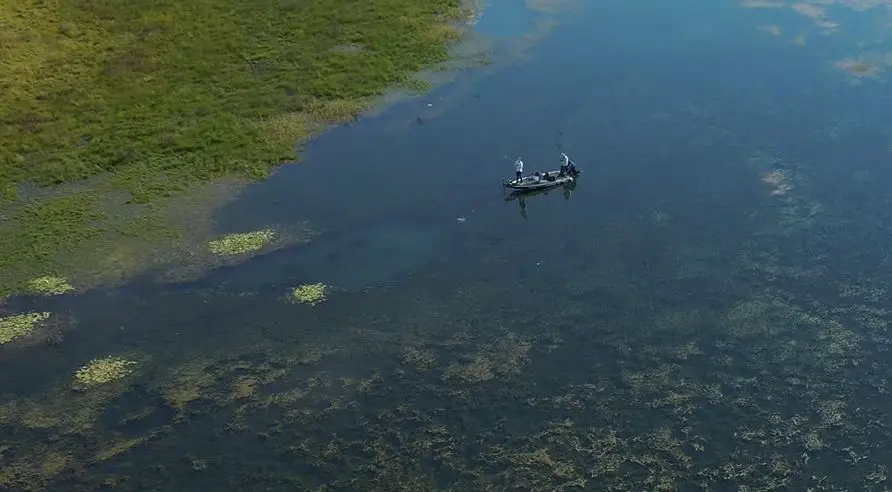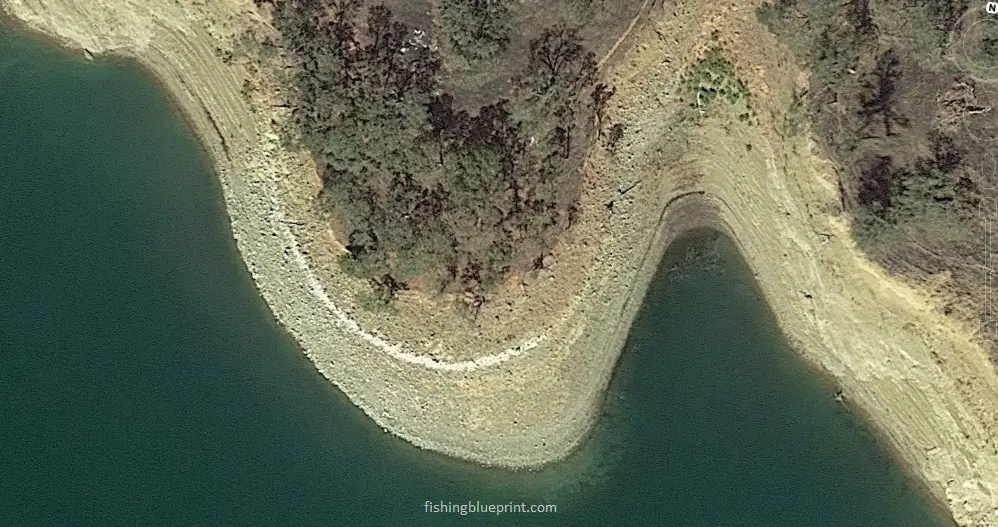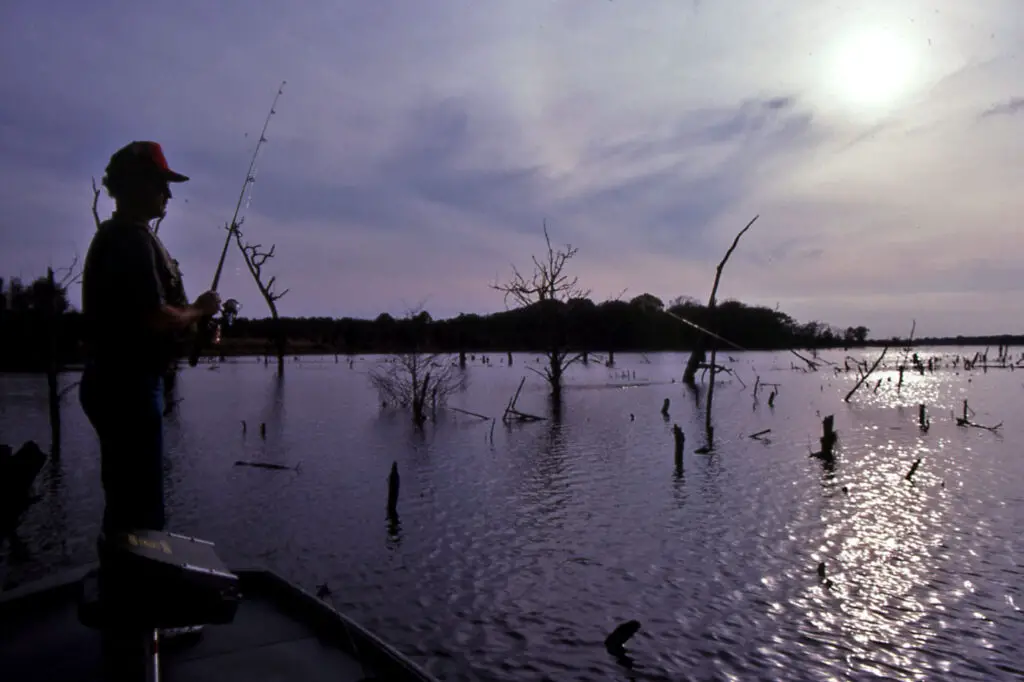What Is A Buzzbait? | How To Fish A Buzzbait For Bass?
Are you finding it hard to fish a buzzbait? Buzzbait fishing is luckily relatively easy to get into. It is not a technique that has a high barrier to entry and requires a ton of new gear to purchase, at least for getting out on a day on the lake. The one-piece of indispensable gear is a good quality buzzbait. Try fishing with a lure that doesn’t run true, the blade doesn’t turn, that blade isn’t loud, or sinks like a rock you could be left with catching nothing, getting your lure hung up, or faced with a painful arm fishing a lure that is just not performing, or worse! In our fishing blueprint, we breakdown everything you need to know about fishing a buzzbait , types, colors, and knowing when and where to fish it to give you the best chances of success. This article helps you identify the factors that are most vital to you so that you can start catching fish quickly and easily.
The buzzbait is one of the most effective choices for luring in smallmouth and largemouth bass, thanks to the unpredictable movement of the bait as it darts around the water.
But be warned! Go through the following guide slowly and carefully to learn how to fish buzzbait lures for bass.
WARNING: There’s a lot of information about this subject you’ll probably want to come back to. No one expects you to remember all these tips. We know your time is precious, so we really tried to over-deliver in value for you. Additionally, we frequently update reports like this, so you’ll want to stay up to date with any changes or additional tips we include for you.
We found that the easiest way to save and bookmark this report so you can come back to it later is to share it on your favorite social media platform, especially if you use your phone to get important tips like the ones in this report here…
Click on your favorite social media buttons to remember this page now!
What Is A Buzzbait?
Below is a brief description of a buzzbait and it’s basic features. If you feel comfortable with this topic, scroll to the next section.
Buzzbait lures create a buzzing sound as they move through the water, which can help attract bass and other large fish. A buzzbait lure is a type of wire lure that typically includes a hook on the long arm and a propeller blade on the short arm.
The blades are responsible for producing the buzzing sound that gives these baits their name. The blades also create more of a disturbance in the water, adding to the ability of the lure to attract bass.
Most buzzbait lures include a skirt that sits around the hook. The skirt is typically silicone or rubber and acts as the lure.
Anglers can also add a trailer to a buzzbait. A trailer is a soft plastic bait that you rig to the hook.
The trailer trails behind the buzzbait, which creates a larger profile and increases the buoyancy of the fishing rig.
What Does a Buzzbait Imitate, and Why Would a Fish Bite It?
Buzzbait can imitate a variety of fish and small prey using different colors and designs for the skirt. The sound, flash, and movement of the buzzbait may imitate shad, frogs, and other small species.
As a buzzbait is a topwater lure, it resembles prey swimming or darting across the top of the water column. Bass are likely to go after a buzzbait due to the vibration and buzz that it produces.
Although buzzbaits made to be fishing on the top of the water column, they are not designed to float, and if the angler is not careful it can sink quickly. So you need to keep the buzzbait in motion to keep it from sinking.
The blades help pull the lure back to the surface as you pull or reel the line. As soon as the lure hits the water, you typically start reeling it in.
You can also pull a buzzbait through weeds and vegetation with less risk of getting caught or ripping your fishing rig. The design makes it perfect for fishing near weeds and cover.
Buzzbaits come in various sizes, with most options ranging from 1/4-ounce to 1/2-ounce. Half-ounce buzzbaits are the most common choice.
What Are the Different Types of Buzzbaits and How Are They Different From Each Other?
Buzzbaits are available in a variety of designs. Some of the most common types of buzzbaits include:
- Single Propeller with No Clacker
- Single Propeller with Clacker
- Double Propeller
- In-line
- Buzzbait Blades with Holes
- Squeaker Buzzbaits
Single Propeller Buzzbait with No Clacker
The standard buzzbait design includes a single propeller with no clacker. It includes a J-shaped wire frame with a single set of propeller blades on the short arm and a hook on the other.
You tie your line at the bend between the short arm and the long arm. This is the most common type of buzzbait and the design most recommended for beginners.
Single Propeller Buzzbait with Clacker
Some buzzbaits include a single propeller and a clacker. A small triangular piece of metal acts as a clacker.
A hinge connects the clacker to the wire frame of the buzzbait. The propeller blades hit the clacker as they spin, which adds to the noise produced by the buzzbait.
Buzzbaits with clackers are great for stained water and fishing at night.
Double Propeller Buzzbait
A double propeller buzzbait includes two sets of blades that sit parallel to each other. The extra set of blades adds twice as much resistance, twice the sound, and twice the surface disruption.
Compared to a single-blade buzzbait, a double-blade buzzbait is easier to use with a slow retrieval. You can pull the buzzbait at a slower pace, as the extra propellers provide more lift.
Double propeller buzzbaits are great for fishing around submerged grass. If you’re looking for a kicker-fish thread on a big tube bait and you’ll get some giants to explode on it.
Inline Buzzbait
An inline buzzbait has a straight or slightly bent frame instead of a J-shaped frame. The blades are in-line with the hook and skirt instead of sitting above it on a separate arm.
Inline buzzbaits tend to move through the water a little easier due to the inline design. Anglers also tend to find that inline buzzbaits are more durable and easier to control during retrieval.
These also work well around grass and you can add a buzzfrog to the end of this bait to drawn in big bites.
Buzzbait Blades with Holes
Buzzbait blades are typically solid pieces of metal. However, you can also find options that feature blades with holes.
The holes help create a bubble trail behind the buzzbait as you pull it through the water. Some anglers claim that the holes alter the sound of the blades, but the main benefit is the additional disturbance created as water passes through the holes.
The blades may contain one to four holes. Anglers also occasionally drill holes to modify existing buzzbait blades.
How To Fish A Buzzbait? Best Retrieval Techniques...
Basic Buzzbait Retrieval
The basic retrieval technique for buzzbait fishing involves a fast retrieval as soon as the lure hits the water. Once the buzzbait hits the surface, start reeling it in to get the blades spinning.
The blade skims across the surface of the water while the skirt and hook glide below it.
The key is to reel in the buzzbait slow enough to keep the blade above the water and the lure tracking vertical.
Another key to effective buzzbait fishing is to try your hardest to bump your lure against objects to attract more attention. For a split second pause your retrieve just after knocking into the object. often this pause triggers a reaction bite.
Burning Your Buzzbait
A faster retrieval keeps the lure on the surface of the water, which kicks up more water and may produce a louder whistling or squealing sound. A faster retrieval is often used in clearer conditions and open areas.
However, if you reel the buzzbait in too fast it will naturally roll on its size and will cause you to lose bites.
To avoid rolling, remove the skirt and replace it with a narrow swimbait, such as a Megabass Spark Shad.
Ultra-Slow Retrieval
Other anglers also use a ultra slow retrieval. Meaning the blades will start to sink just beneath the surface of the water.
They say can could produce more bubbles and increase the water disturbance around the lure.
Additionally, they say, this retrieval is a way to fish around cover, such as weed beds or submerged logs.
I personally do not agree with the ultra-slow technique. There are other more effective ways to fish submerged structure – like when fishing a squarebill crankbait.
Mix It Up
You can also switch back and forth between a fast and slow retrieval. Mixing up your tempo can also trigger more fish to strike.
If one method fails, you can switch to the other. For example, you may start with a fast retrieval to scout an area of the lake for bass activity and then come back through with a slower retrieval if you fail to get any bites.
You should also repeat your casts at least once. Repeated casts in the same area can help stir up more activity and anger the bass, resulting in more aggressive strikes.
5 Great Locations and Structures to Fish a Buzzbait Lure for Bass and Why
Here are five of the best locations and structures to fish buzzbaits for bass:
- Heavy Vegetation
- Open Flats
- Rocks and Riprap
- Docks
- Flooded Areas & Standing Timber
Fishing Buzzbaits Around Grass & Heavy Vegetation
 Buzzbaits are often used in areas with heavy cover. You may use them around vegetation, including grass lines and weeds.
Buzzbaits are often used in areas with heavy cover. You may use them around vegetation, including grass lines and weeds.
Buzzbaits are great for fishing near weeds, as you can typically pull the lure through vegetation without much trouble.
Look for submerged grass and weeds. You may notice a small amount of vegetation just barely touching the water’s surface, which is the ideal location to start fishing a buzzbait.
The vegetation provides food and cover for baitfish, which then attract bass. You can skim your buzzbait across the surface of the water, just over the vegetation.
Fishing Buzzbaits Over Open Flats
 Buzzbaits are often used to cover open flats in search of bass suspended below the surface. You can burn a buzzbait through a large open area using a fast retrieval to cover more ground.
Buzzbaits are often used to cover open flats in search of bass suspended below the surface. You can burn a buzzbait through a large open area using a fast retrieval to cover more ground.
Large flats in lakes also tend to gain a lot of weed growth during the summer. As mentioned, you can easily pull a buzzbait through dense growth.
Fishing Buzzbaits Around Rocks and Riprap Banks
 Look for piles or rock or rocky terrain in shallow waters to find bass during the colder months. The rocks absorb heat from the sunshine, which warms the surrounding waters.
Look for piles or rock or rocky terrain in shallow waters to find bass during the colder months. The rocks absorb heat from the sunshine, which warms the surrounding waters.
On a warm winter or late fall day, you may find more activity near rocks and riprap. Riprap, or rubble, is a collection of rocks placed near shorelines and manmade structures to prevent erosion.
Try retrieving your buzzbait while running parallel to the bank. Retrieving parallel to the bank increases your chances of coming across bass migrating to warmer water.
A common technique involves bumping the buzzbait against an object, such as a rock. The movement can help create more attention and attract more bass.
Fishing Buzzbaits Around Docks

Docks are another popular area to use buzzbaits, as anglers tend to overlook docks when using these types of lures. When anglers see a dock, they often try using a fishing jig due to its vertical motion.
A buzzbait moves through the water horizontally, which gives the fish in the area something different to look at. Presenting something new may help you attract more attention and get more strikes.
You should also try bumping your buzzbait against the docks during your retrieval.
Fishing Buzzbaits Around Flooded Areas & Standing Timber
 Lake levels tend to rise in the spring and summer due to increased precipitation and run-off from tributaries and the surrounding land. The higher water levels can lead to flooding, which creates the ideal conditions for fishing a buzzbait for bass.
Lake levels tend to rise in the spring and summer due to increased precipitation and run-off from tributaries and the surrounding land. The higher water levels can lead to flooding, which creates the ideal conditions for fishing a buzzbait for bass.
The flooded areas offer shallow waters and thick vegetation, which brings all manner of small prey. You are likely to find bass searching for food.
Fishing in flooded areas tends to work best in the early morning and mid-to-late afternoon during the warmer months. The shallower waters grow warmer by the middle of the day, which is when you are more likely to find the bass moving to deeper, cooler water.
How to Make Your Buzzbait Even Louder?
Instead of clackers, anglers will do some interesting things to give their buzzbait even more vibration and a squeaking noise. These lures are often called “squeaker buzzbaits”.
A common trick among old-school anglers is to rough up the rivet just behind the blade with an old file. Then as you’re driving to the lake stick hold the buzzbait out the window. Let it rub and grind against the roughed-up rivet.
Eventually the rivet will start to rust and as the blades rotate, the friction with the rusty rivet creates a high pitched squeak.
A squeaker buzzbait produces a higher pitched noise compared to a clacker buzzbait which creates more of a low pitched “knock” or “clack”.
Overall, the squeaker buzzbait offers more noise when compared to a buzzbait without a clacker, but less noise than a clacker buzzbait.
By the time you get to the lake that buzzbait will be squealing louder than the startled pig.
Buzzbait Clacker: What’s Its Purpose? Should I Use It?
A buzzbait clacker is an additional piece of metal attached to the lure to create more noise. The extra noise can help bass find your buzzbait stained or muddy water.
The concept is similar to putting a baseball card in the spokes of a bicycle wheel. As the blades of the buzzbait spin, they hit the clacker, which creates a loud sound.
You can buy buzzbaits with clackers already installed or purchase clackers to add to existing buzzbaits.
Some anglers also enjoy using clackers when fishing at night. Using a buzzbait clacker with black blades and a black or dark red skirt is a common choice for night fishing and poor water conditions, as the combination of the solid profile and the extra noise may help bass find your lure.
Yet, a clacker is not always ideal during the daytime, as you sometimes need a subtler presentation to encourage strikes from nearby bass. Making too much noise may hurt your chances of hooking a fish, especially in clear conditions with good visibility.
The bottom line is that a buzzbait clacker is not always necessary but may help when fishing at night or in dingy-colored water.
Best Buzzbait Blade Colors and Why?
The blades are often metallic. The most common colors include nickel and gold.
Nickel closely matches silver in appearance and is often used in bright conditions and clear water. Nickel and silver blades can imitate many types of baitfish thanks to the flash produced by the metallic surface.
Gold blades are preferred in low light conditions and lightly stained water. Gold blades have a darker profile that stands out more in water with limited visibility while still offering some flash.
Along with metallic blade colors, you can buy buzzbaits with painted blades. Common painted blade colors include black, red, white, and orange.
Painted blades tend to create a better profile in dirty water, as the sediment can prevent metallic blades from reflecting light.
Best Buzzbait Body and Skirt Colors and Why?
As with the blades, the body and skirt of the buzzbait are available in a variety of colors. Popular colors include black, white, red, orange, and chartreuse.
Anglers often used buzzbaits with black bodies and skirts at night or in murky waters. Black creates more contrast, which increases the visibility of the profile of the buzzbait.
White is the preferred choice for clear conditions. White resembles just about any type of baitfish to the bass swimming below.
Black bodies and skirts are often paired with black or red blades. White bodies and skirts often work well with silver blades.
Soft Plastic Trailer or Trailer Hook? Why Choose One Over the Other?
Adding a soft plastic trailer or a trailer hook is a top recommendation when fishing a buzzbait. You can use a soft plastic trailer with or without the skirt on the buzzbait.
You have the option to remove the skirt all together and add a soft plastic trailer, or you can keep the skirt and add the trailer behind it.
Removing the skirt can create a more natural appearance, which may work well in very clear conditions. Furthermore, it also makes the lure more aerodynamic, allowing you to cast a little further.
If you keep the skirt it will add bulk and size profile to the lure. In addition, skirt material is often metallic and can give the lure added flash for attraction.
Soft plastic trailers are made to resemble various baitfish and prey, including frogs and grubs. They add more weight to the lure, which can help you cast further.
Trailers also add more action and vibration to your presentation, which may help attract bigger bites.
Most anglers find that adding a trailer also makes the buzzbait easier to handle. It adds to the profile and gives the lure more lift, making it easier to skip across the surface of the water.
A trailer hook is a separate attachment that can be used with a buzzbait with or without a soft plastic trailer. Anglers often add a trailer hook to hook more bass when the fish fail to commit to their strikes.
For example, you may find that the bass keeps slapping at your buzzbait without getting hooked. The trailer hook trails the treble hook attached to the body on the buzzbait, giving you a follow-up hook.
A trailer hook can also catch debris, which may be an issue when fishing around weeds and grass. Due to the risk of getting hooked on vegetation, some anglers only use trailer hooks in areas with fewer weeds.
Best Soft Plastic Trailers for Buzzbaits
Soft plastic trailers are available as swimbaits, frogs, grubs, and other small critters. Soft plastic swimbaits are among the most common options as they resemble bait fish swimming in the water.
Soft plastic swimbaits often have long tails that can add more commotion during retrieval. You may also find that it’s easier to keep your lure true as it moves through the water when using a soft plastic swimbait.
These swimbaits vibrate and flap as you move the lure through the water. They work great in colder weather, as the extra water disturbance may attract strikes from lethargic bass.
Soft plastic frogs and toads are also a popular choice for trailers on buzzbaits, as they include two legs and a wider body for adding even more commotion to the water. You may want to try using a soft plastic toad around cover, especially during the spring and summer as lily pads and vegetation start to grow.
Soft plastic grubs work similar to soft plastic frogs. You get a wider profile that you can typically pull through grass lines and cover without any issues.
Grubs may include one or two tails. A single-tail grub often has a hook-shaped tail that flutters as the lure falls and vibrates wildly as you work the buzzbait.
Overall, a soft plastic swimbait adds a little more movement to your lure while a soft plastic frog or grub can produce significantly more commotion.
If you choose to use a soft plastic trailer with a skirt, consider matching the colors. Matching the colors of the skirt and trailer helps maintain a more natural appearance.
For example, if you have a buzzbait with a chartreuse skirt and body, try using a chartreuse soft plastic swimbait, frog, or toad.
What's The Best Buzzbait Setup: Rod, Reel, and Line?
Rod
A rod measuring 6’8” to 7’6” is often used for buzzbait fishing for bass.
A 7-foot rod offers a good middle ground between shorter and longer rods, making it well-suited for most buzzbait fishing techniques. A shorter rod tends to work better for skipping the buzzbait around docks and deep cover where you need more accuracy.
A longer rod works better for casting long distances. However, if the rod is too long for your comfort, you may struggle to control your buzzbait, especially when reeling in large bass.
Most anglers choose a rod with medium-heavy power and fast action. A medium-heavy rod is more versatile and works well with a light lure while fast action increases your chances of successfully hooking bass with a single hook when using a buzzbait.
But if you really want to get the most out of fishing a swim jig you go with a medium-heavy casting rod like a St. Croix Victory Series 7’5″, Medium-Heavy backbone, Fast action tip, they nicknamed the “Max Marshal“.
>>> Click HERE to read the reviews from actual customers about this rod! <<<
This style rod was specifically designed for the serious bass fishing enthusiast according to many reviews.
The rod has great strength and relatively soft, but sensitive tip that make it easy feel the vibration of the blade, detect even the softest of strikes, and the confidence to pull bass out of thick weeds and grass.
It is durable and lightweight with a tip made for strength and sensitivity.
If you’re more on a budget, I recommend a dependable economy casting rod that’s believed by many anglers to be the best casting rod for a beginner. It is low-priced yet it can fish a lot of bass.
Reel
Anglers also tend to use a high-speed reel with buzzbaits. Beginners may want to start with a 7:1 or more gear ratio.
A 7:1 to 8:1 gear ratio allows you to wind in your fishing line faster, which makes it easier to get the blades turning so that they can generate adequate commotion.
Yet, if you don’t use a fast retrieve, you may notice a slower reel will make it difficult to keep the buzzbait above the water.
So I recommend using a quality Shimano casting reel to use with either of these rods. Most anglers choose a higher-speed gear ratio of 6.6:1 or higher.
>>> Click HERE to read the reviews from actual customers about this reel! <<<
I forgot to mention, a higher speed reel is preferred because if the bass are in cover or deep in the vegetation you don’t want them to wrap themselves around anything that’s going to cause you to break off your lure and lose the fish…
You need to get the bass out fast and that is what a fast reel does.
Line
Monofilament, fluorocarbon, and braided fishing lines are all suitable for use with buzzbaits.
There are three groups that debate which is the best line to use.
Some anglers like to use straight braided fishing line in 50-to-65-pound test strength.
Braided fishing line is strong and doesn’t stretch. The strength of a braided line is useful when fishing near weeds and cover.
Braided fishing line also floats, which is useful for keeping a topwater lure near the surface, such as when using a buzzbait.
Unfortunately, the braided line can wrap around the blade very easily and can frequently foul your casts.
The other group likes to use only monofilament line in stronger test limits, 20-25-pound test.
Monofilament line doesn’t sink but at lower strength tests it can be very stretchy. Furthermore, it doesn’t cast as far as the braided line.
Personally, I belong to the third group… A mixture of both…
I can’t remember where I got this advice, but since then it’s increased my hookup ratio 3-fold, and I’m sure it will help you do the same.
I strongly advise anglers to use 50-to-65-pound braided line as their mainline, then tie on a 5-6 foot leader of monofilament in a 17-20-pound test.
Here’s my reasoning… I get the long casting distance, floating and zero stretch features with the braided line. Then my monofilament leader line floats, stays straight, avoids wrapping around the blade, and the higher strength test line isn’t overly stretchy, and acts like a shock absorber for hard hitting fish.
It’s kinda line I’m getting the best of both worlds.
How To Set the Hook When Fishing Buzzbaits for Bass
Most anglers recommend waiting for about two seconds after you feel a strike before you set the hook. If you start reeling your line in too early, you may pull the lure away from the bass before they get a good bite.
Another suggestion is to keep the tip of your rod pointed upward during retrieval. Instead of keeping the rod pointed at 9 o’clock or 10 o’clock, point it up to 11 o’clock.
Keeping your rod up should help you feel more of the weight of the strike when it occurs. The pull from the bass should bring your rod down, allowing you to pull it up to set the hook.
If you notice a swirl of water or feel a strike without the bass taking the buzzbait, drop the tip of your rod. This allows the lure to flutter in place like a stunned baitfish, which may encourage a second strike from the bass.
Checkout These Other Topwater Fishing Articles...
- New Report Reveals Insider Topwater Bass Lures Secrets To Anglers Who Want To Catch More Fish – But Can’t Get Started
- LET'S GET BUZZED! Secrets On How To Fish A Buzzbait [Fishing Tips On When, How, and Where]
- Why Most Fishing With A Frog Lure FAIL [17+ Plastic Frog Secrets You Must Know]
- The 5 Crucial Steps of Fishing Walking Baits (Yep! These are the Secrets Pros Never Give Out – And Now They’re Yours!)
- The Devastating Secrets of Topwater Popper Fishing (the Rookies Method of Effective Fishing… No Matter How Uncoordinated or Clumsy You Are!)
- Best Rod for Buzzbaits, Frogs, Heavier Poppers and Walking Baits, and MORE!
- Best Rod for Normal-to-Lighter Weight Topwater Baits: Poppers, Walking Baits, Wake Baits, and MORE!
Other Bass Fishing Articles Just For You...
Funny Fishing Rules, Laws, and Regulations 2025
Crazy Fishing Laws That Will Blow Your Mind! #7 is INSANE! Strange Fishing Regulations and Laws As silly as hook and rod limits may seem,
EXPOSED! How To Use A Spinnerbait The Right Way for 2025
Are You Wondering How To Use A Spinnerbait? Or How To Work A Spinnerbait Over Grass, Logs, or Points? Well, All These Questions Are Answered
EXPOSED! Best Crankbait Colors for 2025 [Which to Buy & Avoid]
What color crankbait to use? Crankbait Color Chart I just love going into a Bass Pro Shops store and just staring at all the walls
Best Underwater Dock Lights For Fishing – 2025 Buyers Guide
Night Dock Light Fishing For Beginners Dear fellow angler, Does this sound like you? You’re someone who loves fishing but just wants to escape the
15 Best Deep Diving Crankbaits [2025 Buyers Guide – Which to Buy & Avoid]
A Complete Buyer’s Blueprint On The Best Deep Diving Crankbaits for Bass, Walleye, or Striped Bass On The Market Today Fishing deep diving crankbaits can
